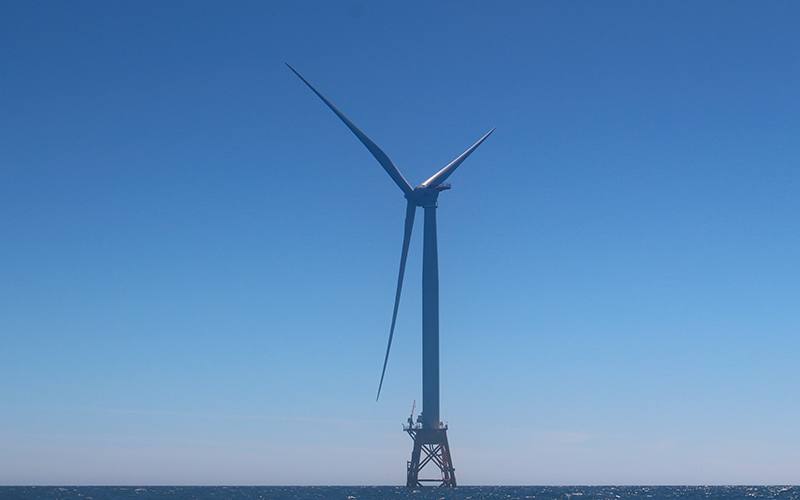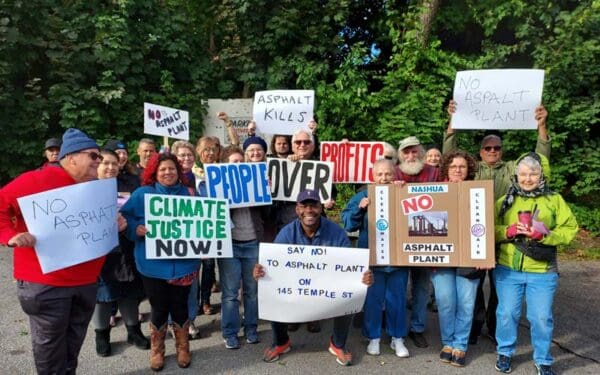
A wind turbine placed off Rhode Island. Photo: Laurie O'Reilly
The Gulf of Maine is a beloved and unique “sea within a sea” off the coast of Maine. The waters provide a home to more than 3,000 species of wildlife, including marine mammals, fish, birds, turtles, and invertebrates, making it one of the most productive ecosystems in the world. Unfortunately, it’s also warming faster than 97% of the world’s waters, threatening coastal fisheries and iconic species like right whales.
The clean, renewable energy supplied by offshore wind could be a vital step to slowing climate change and its damaging effects on the region’s marine life. The Gulf of Maine’s accessible ports, open waters, and strong breezes make it ideal for offshore wind development. But it will succeed only if we implement it thoughtfully, with care for the wildlife, habitats, and people who rely on the ocean’s bounty.
That’s why CLF is fighting to ensure that the development of offshore wind projects in the Gulf of Maine is done responsibly and equitably. Right now, federal regulators are considering where and how they will place offshore wind turbines in the Gulf of Maine. The designated Wind Energy Area released by the federal Bureau of Ocean Energy Management takes steps in the right direction, but more work must be done.
Protecting the Gulf of Maine’s people
The Gulf of Maine drives industry and commerce in New England. Tourists flock to our shores to enjoy the wind and the waves. Generations of fishermen have built a livelihood out of lobster, Atlantic cod, and more. A thriving ocean ecosystem is key to our economic well-being, and it must be recognized in any plan for offshore wind.
The Wind Energy Area recently designated by the Bureau for potential leasing avoids most of the vulnerable habitat and wildlife areas we identified and important lobstering grounds. But fishermen have expressed concerns that other important historical fishing grounds are at risk. These concerns deserve to be evaluated and addressed.
It’s also important to bear in mind that these waters are sacred to the many Indigenous tribes who have safeguarded them for thousands of years.
Some tribes have raised concerns that the government is not fully including them in the offshore wind development process, and those concerns must be addressed. In particular, CLF is calling on the Bureau of Ocean Energy Management to recognize the unceded fishing rights of the Wabanaki people of Maine and to engage with tribal leaders closely throughout the development process.
Protecting the Gulf of Maine’s wildlife
Many of the 3,000 species of wildlife relying on a healthy Gulf of Maine are endangered, threatened, or vulnerable. Poorly implemented offshore wind could put them at risk. Right whales, cod, and cold-water corals are just a few of the key species we must protect in any plan for offshore wind.
Many critically endangered North Atlantic right whales make the Gulf their fall home. They migrate through its waters and feast upon the tiny copepods that make up their diet. The areas designated by the Bureau for offshore wind development exclude many of their key migration and feeding grounds.
However, there are still some areas of vital habitat included in the Wind Energy Area which should be excluded from consideration. Offshore wind development can interfere with whales’ ability to feed, and pose risks of whales becoming entangled in debris caught up in the new structures or hit by boats conducting construction or maintenance.
Cod and New England’s corals are also currently facing significant threats. Protecting important habitat is a necessary step in protecting and rebuilding their population. That’s why we’re grateful that the Bureau’s designated Wind Energy Area largely avoids known important habitat for these species.
Protecting the Gulf of Maine’s future
One of the biggest challenges facing efforts to develop offshore wind in the Gulf of Maine responsibly is the need for more data. Rectifying this issue will require promptly gathering more comprehensive information. As the plans for offshore wind energy evolve, we encourage the Bureau of Ocean Energy Management to begin an in-depth baseline monitoring program.
The Gulf of Maine would also benefit from adopting a “phased leasing” approach. This means auctioning off parcels of the available area gradually over time. This approach allows scientists to gather more data to better understand the Gulf of Maine ecosystem and make more informed decisions about how to develop offshore wind responsibly.
Protecting the Gulf of Maine from climate change
The Gulf of Maine is an irreplaceable natural resource facing a dire threat from climate change. If we act carefully, we can use offshore wind to help protect the Gulf from the impacts of climate change while minimizing impact to the environment and the people who rely on it.




